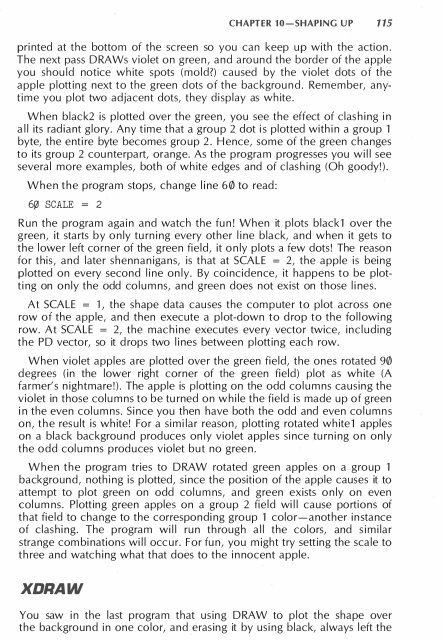williams-et-al-1983-apple-ii-computer-graphics
williams-et-al-1983-apple-ii-computer-graphics
williams-et-al-1983-apple-ii-computer-graphics
- No tags were found...
Create successful ePaper yourself
Turn your PDF publications into a flip-book with our unique Google optimized e-Paper software.
CHAPTER 10-SHAPING UP 115printed at the bottom of the screen so you can keep up with the action.The next pass DRAWs viol<strong>et</strong> on green, and around the border of the <strong>apple</strong>you should notice white spots (mold?) caused by the viol<strong>et</strong> dots of the<strong>apple</strong> plotting next to the green dots of the background. Remember, anytimeyou plot two adjacent dots, they display as white.When black2 is plotted over the green, you see the effect of clashing in<strong>al</strong>l its radiant glory. Any time that a group 2 dot is plotted within a group 1byte, the entire byte becomes group 2. Hence, some of the green changesto its group 2 counterpart, orange. As the program progresses you will seesever<strong>al</strong> more examples, both of white edges and of clashing (Oh goody!).When the program stops, change line 6(/J to read:6 SCALE = 2Run the program again and watch the fun! When it plots black1 over thegreen, it starts by only turning every other line black, and when it g<strong>et</strong>s tothe lower left corner of the green field, it only plots a few dots! The reasonfor this, and later shennanigans, is that at SCALE = 2, the <strong>apple</strong> is beingplotted on every second line only. By coincidence, it happens to be plottingon only the odd columns, and green does not exist on those lines.At SCALE = 1, the shape data causes the <strong>computer</strong> to plot across onerow of the <strong>apple</strong>, and then execute a plot-down to drop to the followingrow. At SCALE = 2, the machine executes every vector twice, includingthe PD vector, so it drops two lines b<strong>et</strong>ween plotting each row.When viol<strong>et</strong> <strong>apple</strong>s are plotted over the green field, the ones rotated 9(/Jdegrees (in the lower right corner of the green field) plot as white (Afarmer's nightmare!). The <strong>apple</strong> is plotting on the odd columns causing theviol<strong>et</strong> in those columns to be turned on while the field is made up of greenin the even columns. Since you then have both the odd and even columnson, the result is white! For a similar reason, plotting rotated white1 <strong>apple</strong>son a black background produces only viol<strong>et</strong> <strong>apple</strong>s since turning on onlythe odd columns produces viol<strong>et</strong> but no green.When the program tries to DRAW rotated green <strong>apple</strong>s on a group 1background, nothing is plotted, since the position of the <strong>apple</strong> causes it toattempt to plot green on odd columns, and green exists only on evencolumns. Plotting green <strong>apple</strong>s on a group 2 field will cause portions ofthat field to change to the corresponding group 1 color-another instanceof clashing. The program will run through <strong>al</strong>l the colors, and similarstrange combinations will occur. For fu n, you might try s<strong>et</strong>ting the sc<strong>al</strong>e tothree and watching what that does to the innocent <strong>apple</strong>.XDRA WYou saw in the last program that using DRAW to plot the shape overthe background in one color, and erasing it by using black, <strong>al</strong>ways left the


